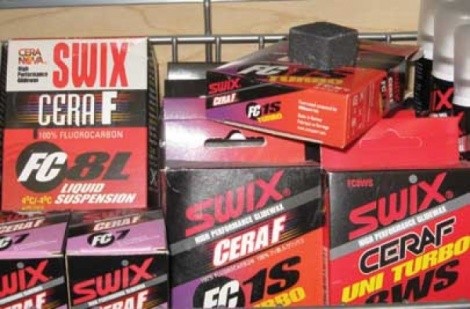“The biggest myth about waxing is that you only have to do it once a year,” says Sports Den ski and board tech Jeff Sadis. “The reality is, you need to wax your skis or snowboard every three or four days that you use them. High-level competitors do it after every time that they ride, but recreational racers and the general public can get away with three or four.”
Sadis, who gave this interview while repeatedly riding up the lift and skiing down to the start at the X Games while testing the snow, knows what he’s talking about. He’s considered among the world’s best “servicemen” for the discipline of ski cross, where four or five athletes jump out of the start gate together, then race down a narrow course filled with banks and jumps, each one trying to pass the others to get in front. First one through the finish wins. The right wax is essential.
“There’s a lot of gliding involved,” Sadis says. “You have to make the skis slick enough so they’ll go fast.”
There are dozens of different kinds of wax, plus base layers and the topcoat overlays used by racers. Some cost more than $100 an ounce. But everyday snowriders need only a general all-temperature wax, which can be found at most ski or snowboard shops or sporting stores. Skis and boards can use the same kind of wax. Aside from allowing the base of the skis or board to ride more easily and smoothly over the snow, the wax protects the base, making your equipment last longer.
A general wax is fine for free riding, but Sadis advises, “If you compete, you should have a wide array of waxes that will cover a range of temperatures. The wax color indicates its temperature range. Lighter colors are for warmer snow; darker is for colder. They usually range from green for the coldest snow, then blue, white, red and yellow. Red is the middle of the spectrum. Yellow is for wet spring snow.” Using yellow for warm, wet snow will help you avoid the jerky sticking of your gear when spring pollen and moisture cause the familiar stop-and-go suction.
There are also many pricey fluorocarbon waxes and overlays. Today, all competitions, even halfpipe contests, demand speed. You can’t win without fluoro. But fluorocarbon is actually poisonous to breathe, so servicemen always wear respirators when using it. If you’re ironing in a fluoro and don’t have a respirator, apply the wax near an open window or door.
If you value your gear, use a waxing iron rather than an ordinary clothing iron. Temperatures of regular irons vary, and worse, they get too hot. That can burn your base or destroy the wax. A genuine waxing iron is expensive—good ones start at around $50 to $80—but it pays for itself by making your equipment last longer and handle better.
For racers and others who like to go down the mountain as fast as possible, there’s some big news from Swix. The company is developing a new race overlay that will be called High Velocity Cera. Steven Poulin, president of Swix, says it’s not yet available to the public. “It’s a liquid with no solvents,” Poulin says, “and it will have a broad temperature range. We’re still finishing the testing, but it’s already being used on the World Cup.”
I remember being in an FIS race in Colorado when Cera F, Swix’s rub-in fluoro overlay powder, came out. We all stood around in little groups, pleading with those who had it to sell us some. It was like a bunch of drug deals. But it was urgent, because if you didn’t have Cera F, you could not win. It was as simple as that.
Poulin admits this new overlay will be the same. It will be a topcoat that will give a significant advantage over the powers. It will seal the top (meaning the base) of the ski or snowboard. “We’ll bring it to market about a year from now,” he says.
Also news: Swix has bought out its biggest competitor, Toko Wax. That means Swix now has 85 percent of the ski-wax market in the United States, and 75 percent of the market internationally.
